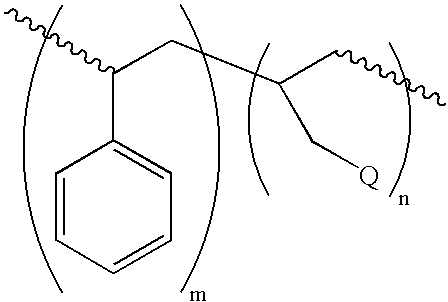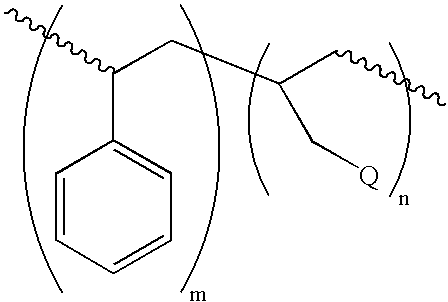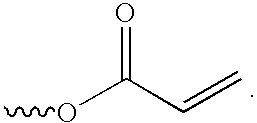Derivatives of poly(styrene-co-allyl alcohol) and methods for use thereof
a technology of thermosetting composition and derivatives, which is applied in the direction of adhesive processes with surface pretreatment, solid-state devices, electrical equipment, etc., can solve the problems of increasing the demand for smaller and more powerful electronic components, and achieve the effect of low ionic impurities and easy conversion to desired compounds
- Summary
- Abstract
- Description
- Claims
- Application Information
AI Technical Summary
Benefits of technology
Problems solved by technology
Method used
Image
Examples
example 1
[0070]Poly(styrene-co-allylvinyl ether): A 125 mL flask was charged with 4.5 g (10 milliequivalents) SAA-103 (Lyondell), 25 mL toluene, 10.88 g (109 milliequivalents) butylvinyl ether, and 102 mg of Pd(OAc)2 phenanthroline complex. This mixture was stirred overnight at 55° C. An FTIR the following morning demonstrated that almost all of the alcohol function had disappeared. Another 10.15 g portion of n-butylvinyl ether was added and stirring at 55° C. was continued for another nine hours. The crude product was extracted with two 10 mL portions of methanol. The solution of the product that remained in toluene plus excess butylvinyl ether was then passed over 12 g of silica gel. The solvent was removed to yield a glassy, clear, light-yellow solid. There was no evidence via IR of any residual hydroxyl functionality and new absorptions at 1635, 1319, 1200, and 812 wavenumbers were present in the product.
example 2
[0071]Poly(styrene-co-allyl acrylate): A 250 mL flask was charged with 22.4 g (50 milliequivalents) of SAA-103, 7.2 g (100 milliequivalents) acrylic acid, 1.0 g methanesulfonic acid, and 100 mL toluene. The flask was equipped with a stir bar, Dean-Stark trap, and condenser. The mixture was refluxed under an air sparge for 90 minutes and 1.1 mLs water was collected. The catalyst, and excess acrylic acid, were neutralized by stirring the solution with 7.5 g NaHCO3 for two hours. The solution was extracted with two 100 mL portions of methanol, and then passed over 20 g of silica gel. The solvent was removed to yield 21.2 g of a friable, clear yellow solid. An FTIR on this product revealed that the hydroxyl function was completely absent and new absorptions at 1723, 1635, 1406, 1272, 1189, and 809 wavenumbers were present.
example 3
[0072]Poly(styrene-co-allyl cinnamate): A 125 mL flask was charged with 22.4 g (50 milliequivalents) SAA-103, 8.0 g cinnamic acid, 0.3 g methanesulfonic acid, and 50 mL toluene. The flask was equipped with a stir bar, Dean-Stark trap, and a condenser. The mixture was refluxed overnight and 0.9 mL water (equivalent to theory) was collected. The acid was neutralized in the product by stirring it with 5.2 g NaHCO3 plus 2.5 g H2O for three hours. The toluene solution was passed over 21 g silica gel and then evaporated to yield 20.2 g of a friable, light-yellow polymer. The FTIR spectrum of this polymer showed no evidence of residual hydroxyl functionality. There were new absorptions at 1713, 1636, 1309, 1167, and 766 wavenumbers.
PUM
| Property | Measurement | Unit |
|---|---|---|
| weight percent | aaaaa | aaaaa |
| temperatures | aaaaa | aaaaa |
| Tg | aaaaa | aaaaa |
Abstract
Description
Claims
Application Information
 Login to View More
Login to View More - R&D
- Intellectual Property
- Life Sciences
- Materials
- Tech Scout
- Unparalleled Data Quality
- Higher Quality Content
- 60% Fewer Hallucinations
Browse by: Latest US Patents, China's latest patents, Technical Efficacy Thesaurus, Application Domain, Technology Topic, Popular Technical Reports.
© 2025 PatSnap. All rights reserved.Legal|Privacy policy|Modern Slavery Act Transparency Statement|Sitemap|About US| Contact US: help@patsnap.com



